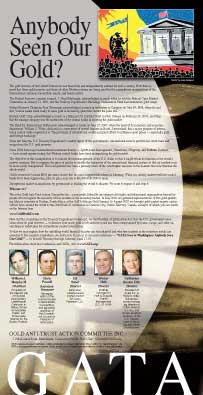You are here
Adrian Douglas: GFMS publishes a sham against silver
By Adrian Douglas
Thursday, April 23, 2009
GFMS has issued a 41-page report on the silver market:
http://www.silverinstitute.org/pr22apr09.php
It is a complete sham -- misinformation and garbage.
For example: "Starting with retail investors, part of this group, primarily investors based in North America, continues to consider silver to be a quasi-monetary commodity. After all, silver ceased to be part of the United States' monetary system only in the 1960s. Some players consider silver (as well as gold) to be a superior store of value to fiat money, due to the latter's arguably not bearing any intrinsic value. These investors are understood to have 'kept the faith,' to varying extents, throughout the bear market of the 1990s, while some seem to subscribe to various theories of silver price suppression."
How about that? Fiat money "arguably not bearing any intrinsic value"! What is there even to argue about? Fiat isn't even printed anymore; it's stored as a number on a computer. If you unplug the computer or hit it with a virus, all record of your money disappears.
GFMS says "some seem to subscribe to various theories of silver price suppression." How arrogant of GFMS! The Federal Reserve has announced that it will suppress interest rates with "quantitative easing." Has the silver market somehow been vaccinated against price suppression so that it could be immune to this?
These so-called experts on the silver market fail to mention in their report that the Enforcement Division of the U.S. Commodity Futures Trading Commission is conducting an investigation into possible manipulation of the silver market and has been doing so for seven months.
GFMS claims that private investors in silver since the last bull market ended in 1980 have been "disinvesting" their silver and are responsible for the price dropping to ridiculously low levels, levels below the cost of production:
"The net disinvestment in the latter part of the 1980s and throughout the 1990s that we comment on in this report obviously had a major impact on the level of private bullion stocks. At the beginning of the aforementioned period, inventories were enormous, reflecting the heavy investment demand, which had previously taken place during the then recently ended bull market. The subsequent liquidation of a good part of these bullion stocks undoubtedly did much to keep silver prices under pressure thereafter. As we explain in Chapter 7, though, the persistent market deficits of the 1990s were mainly covered by sales of private bullion stocks, this silver ending up in fabricated products."
But then later in the report GFMS has a problem with this being totally incongruous with other facts from the COMEX: "When it comes to annual averages, investors' net positions, although they have fluctuated in size, have remained on the long side over the past two decades. This is particularly curious given the large-scale and sustained disinvestment of physical silver we have noted that took place in the 1990s."
Yes, GFMS, it certainly is curious, isn't it? Private investors are apparently dishoarding silver bullion over two decades in quantities sufficient to crater the silver price and at the same time private investors are consistently NET LONG on the COMEX.
Is this some sort of joke like "How does a blonde hedge her silver investment? She sells the metal and buys futures!"
How can GFMS print such garbage? But wait! This is what GFMS says at the beginning of its report:
"GFMS Ltd. is the world's foremost precious metals consultancy, specializing in research into the global gold, silver, platinum, and palladium markets. GFMS is credited with producing the most authoritative surveys of the gold and silver markets."
I don't know who credits them with producing the most authoritative reports on gold and silver but I would guess it is people who know nothing about gold and silver. I will, however, bestow upon GFMS my token of
recognition for their report by nominating them for my prestigious 2009 Moron of the Year Award.
GFMS does not discuss how the U.S. Government had 5 billion ounces of silver in the 1950s and now has none. After all, if GFMS mentioned this it might cast doubt on their contention that private investors as a group were dumping physical silver for two decades while going long on the COMEX.
GFMS has a real howler of a discussion on OTC derivatives:
"The main advantages of using OTC products are related to costs, flexibility, and confidentiality. Starting with the cost argument, the lack of a formalized marketplace, the limited requirement for reporting by implication, and the economies of scale related to higher ticket sizes result in the overall costs of operating on the OTC market being lower. Part of this decline is certainly passed to the investor. Regarding
flexibility, depending on the respective issuers, the OTC market allows for tailor-made products to be created in order to satisfy the specific needs of various investors as well as provide scope for higher unmargined
leverage than that offered on a futures exchange.
"Finally, the opacity that is inherent in trading OTC products (related to the aforementioned relaxed reporting requirements, at least compared to the various futures exchanges), is another factor that pushes certain players toward OTC products. This property of the OTC market is particularly attractive to investors of substantial size, whose actions could distort the market in a counterproductive manner."
Well, thank you, GFMS, for confirming what the Gold Anti-Trust Action Committee has alleged for 10 years. The OTC market does provide the opacity for investors of size like JPMorganChase or HSBC, whose actions indeed distort the silver market "in a counterproductive manner" -- and they do so with impunity.
Try not to laugh when reading this next quote from the GFMS report:
"In the case of silver, the OTC market offers an additional advantage to investors. Specifically it provides them with an avenue to tax-free silver, in countries where physical purchases are taxable. For instance, in Europe investors can accumulate silver free from value-added tax, as long as the metal is in the form of unallocated as opposed to allocated metal accounts. As a result, many players who, were it not for the tax considerations, would normally purchase physical silver, are drawn into this segment of the market to avoid paying tax, at the expense of somewhat higher counterparty risk."
You probably fell off your chair laughing. That is, the OTC market apparently allows you to accumulate imaginary silver so as to avoid paying value-added tax, which is levied only on real silver. So the silver cartel can manipulate markets with imaginary silver and not even have to pay tax. How convenient!
Apparently, though, exotic derivatives that are somehow related to silver have a "somewhat higher counterparty risk"!
The "experts" at GFMS fail to mention that the OTC derivatives market for contracts of maturity of less than one year is actually considerably bigger in dollar value than all the silver mined annually in the world. Now calling that "somewhat higher counterparty risk" is like saying that stepping on a land mine can cause you some inconvenience.
In its report GFMS goes to great lengths to extol the
virtues of silver exchange-traded funds. Considering their not too well-disguised antagonism to silver it would be fair to conclude that silver ETFs are not fully backed by silver. This is how they describe ETFs: "Silver ETFs are essentially securities that
are listed on stock exchanges, which are fully backed by
positions in allocated metal."
"Positions in allocated metal"? What sort of nonsense is
that? A "position" in something sounds like some sort of trade. Maybe a derivative? For example, one of those wonderful derivatives that don't require you to pay any VAT?
Nowhere does this supposedly authoritative report mention GoldMoney.com. Could it be because GoldMoney holds 100-percent allocated metal for its customers audited by a third party?
GFMS has something of note to say about silver leasing:
"Facilitated by the wider revolution in the financial services sector and fabricators' desire to remove the cost of silver stocks from their balance sheets, the amount of silver on lease exploded during the 1990s and the first part of this decade. From the perspective of flows of privately owned bullion stocks, a gradual change of ownership has taken place: Stocks that were previously owned by the industry have been unwound, passed to, primarily, investors and then borrowed back. The fact is that, in contrast to the gold market, where the bulk of liquidity is provided by central banks, most silver lending is sourced from private-sector stocks."
But GFMS conveniently fails to mention whether this massive private-sector lending is conducted with the knowledge and consent of the private sector owner. Who are all these private investors who are providing the liquidity to the silver users?
Could they be the silver ETFs, which are backed by a only a "position" in allocated silver because the allocated silver is loaned out?
-----
Adrian Douglas is publisher of the Market Force Analysis letter (www.MarketForceAnalysis.com) and a member of the Gold Anti-Trust Action Committee's Board of Directors.
* * *
Help keep GATA going
GATA is a civil rights and educational organization based in the United States and tax-exempt under the U.S. Internal Revenue Code. Its e-mail dispatches are free, and you can subscribe at:
To contribute to GATA, please visit:
http://www.gata.org/node/16








